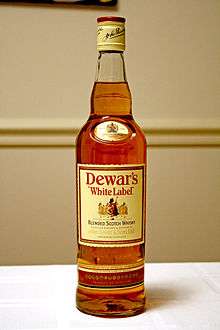Fifth (unit)
A fifth is a unit of volume formerly used for wine and distilled beverages in the United States, equal to one fifth of a US liquid gallon, 4⁄5 quart, or 25 3⁄5 US fluid ounces (757 ml); it has been superseded by the metric bottle size of 750 mL,[1] sometimes called a metric fifth, which is the standard capacity of wine bottles worldwide and is approximately 1% smaller.

History
Before the mid 19th century, the capacity of British alcohol bottles used for wine and distilled liquors was nominally a quart, but the actual capacity varied considerably. Four primary styles existed, with different average capacities: 759±27ml (715-810 range); 781±47ml (724-880); 808±49ml (739-835); ~1130ml "imperial wine quart". Beer and cider bottles had a different range of sizes.[2] In 1842, it was reported that ordinary wine bottles were 1/6 of an imperial gallon, that is, 758ml.[3]
In the late 19th century, liquor in the US was often sold in bottles which appeared to hold one US quart (32 US fl oz; 950 ml), but in fact contained less than a quart and were called "fifths" [4] or commercial quarts.[5]
At this time, one-fifth of a gallon was a common legal threshold for the difference between selling by the drink and selling by the bottle or at wholesale,[5][6][7] and thus the difference between a drinking saloon or barroom and a dry-goods store.
The fifth was the usual size of bottle for distilled beverages in the United States until 1980.[8] Other authorized units based on the fifth included 4⁄5 pint, called a tenth, and 1⁄10 pint.[9]
During the 1970s, there was a push for metrication of U.S. government standards. In 1975, the Bureau of Alcohol, Tobacco and Firearms, in cooperation with the Distilled Spirits Council of the United States, proposed metric-standard bottle sizes to take effect in January 1979 and these standards were incorporated into Title 27 of the Code of Federal Regulations.[9][10] These new sizes were 50ml, 100ml, 200ml, 375ml (355ml for cans), 500ml (discontinued in June 1989),[11] 750ml, 1 litre, and 1.75 litre.
See also
References
- E. Frank Henriques, The Signet Encyclopedia of Wine, p. 298
- Olive R. Jones, Cylindrical English Wine and Beer Bottles 1735-1850, Studies in Archaeology and History, Environment Canada, 1986 full text, Appendix B, Tables 20-23
- Jones, p. 109
- United States Congress, "Report of hearings on H.R. 16925 to Regulate the Storage of Food Products in the District of Columbia", January 24, 1910, p. 300
- Municipal League of Los Angeles, Municipal Affairs 2:1 (January 1907) "commercial+quart" p. 4
- The Southwestern Reporter 55, 1900, p. 212
- Annual report of the Board of State Viticultural Commissioners (California), 1894, p. 71
- testimony of Carl L. Alsberg, "Amendments to the Pure Food and Drugs Act", Commonwealth of Virginia, 1919, p. 17: "The ordinary whisky bottle contains one-fifth of a gallon, or 253⁄5 ounces [...] They are either marked 25 ounces, or one-fifth of a gallon."
- 27 CFR Chapter I, Part 5, Subpart E, Section 5.47a Metric standards of fill for distilled spirits bottled after December 31, 1979
- "Old Standard Fifth Due New Moniker", Indiana Evening Gazette, 16 July 1975, p. 40
- "Packaging regulations for alcoholic beverages". Colostate.edu. Colorado State University. Archived from the original on 12 March 2015. Retrieved 12 March 2015.